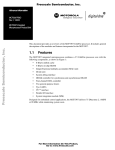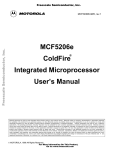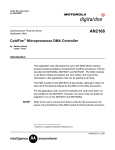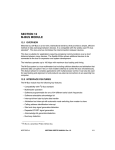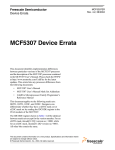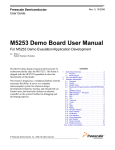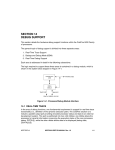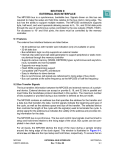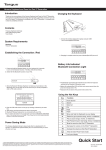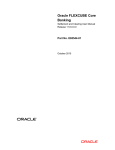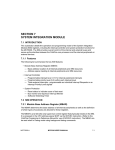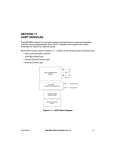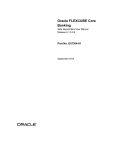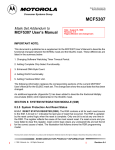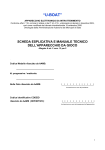Download SECTION 8 CHIP-SELECT MODULE
Transcript
SECTION 8 CHIP-SELECT MODULE 8.1 INTRODUCTION The Chip-Select module provides user-programmable control of the eight chip-select and four write-enable outputs. This subsection describes the operation and programming model of the chip-select registers, including the chip-select address, mask, and control registers. 8.1.1 Features The following list summarizes the key chip-select features: ¥ Eight programmable chip-select signals ¥ Address masking for memory block sizes from 64k to 2G ¥ Programmable wait states and port sizes ¥ Programmable address setup ¥ Programmable address hold for read and write ¥ Programmable wait states and port sizes for default memory ¥ Alternate master access to chip-selects 8.2 CHIP-SELECT MODULE I/O 8.2.1 Control Signals The chip-select controller outputs eight chip-select and four write-enable signals. The chipselect controller activates these signals for ColdFire core-initiated transfers as well as during alternate master-initiated transfers. The chip-select controller can also output transfer acknowledge during alternate master transfers. 8.2.1.1 CHIP-SELECT (CS[7:0]). These active-low output signals provide control for peripherals and memory. CS[7:4] are multiplexed with upper address signals (A[27:24]) and the write-enable (WE[3:0]) signals. CS[0] provides the special function of global chip-select to let you relocate boot ROM at any defined address space. CS[1] provides the special function of asserting during CPU space accesses including interrupt acknowledge cycles. 8.2.1.2 WRITE-ENABLE (WE[3:0]). These active-low output signals provide control for peripherals and memory during write transfers. WE[3:0] are multiplexed with upper address and upper chip-select signals. MOTOROLA MCF5206 USERÕS MANUAL Rev 1.0 8-1 Chip-Select Module During a write transfers, these outputs indicate which bytes within a long-word transfer are being selected and which bytes of the data bus will be used for the transfer. WE[0] controls D[31:24], WE[1] controls D[23:16], WE[2] controls D[15:8] and WE[3] controls D[7:0]. These signals provide byte data-select signals that are decoded from the SIZx, A[1:0] signals in addition to the programmed port size and burst capability of the memory being accessed, as shown in Table 8-1. Table 8-1. Data Bus Byte Write-Enable Signals WE[2] WE[3] D[31:24] D[23:16] D[15:8] D[7:0] WE[0] TRANSFER SIZE PORT SIZE 8-BIT BYTE 16-BIT 32-BIT BURST 0/1 0/1 0/1 0 SIZ1 0 0 0 0 SIZ0 A1 WE[1] A0 0 0 0 1 1 1 0 1 0 1 1 1 1 1 0 0 1 1 1 1 1 0 1 1 1 0 0 0 1 1 1 0 1 1 0 1 1 1 1 0 0 1 1 1 1 1 1 0 1 1 0 0 0 1 1 1 0 1 1 0 1 1 1 1 0 1 1 0 1 1 1 1 1 1 0 0 0 0 1 1 1 0 1 0 1 1 1 1 1 0 0 1 1 1 1 1 0 1 1 1 8-BIT WORD 1 16-BIT 32-BIT 8-2 0/1 0/1 1 1 1 0 0 0 1 1 1 0 1 0 1 1 1 1 0 0 1 1 1 0 1 1 0 1 1 1 0 0 0 0 1 1 0 1 0 0 0 1 1 0 0 0 0 1 1 1 0 1 1 0 0 0 MCF5206 USERÕS MANUAL Rev 1.0 MOTOROLA Chip-Select Module Table 8-1. Data Bus Byte Write-Enable Signals (Continued) WE[2] WE[3] D[31:24] D[23:16] D[15:8] D[7:0] WE[0] TRANSFER SIZE PORT SIZE BURST 0 SIZ1 0 SIZ0 A1 WE[1] A0 0 0 0 1 1 1 0 1 0 1 1 1 1 1 0 0 1 1 1 1 1 0 1 1 1 8-BIT 1 0 1 0 0 1 1 1 1 0 1 1 1 0 LONG WORD 0 0 0 1 0 0 1 1 1 1 1 0 1 1 1 0 0 0 0 1 1 1 0 0 0 1 1 0 16-BIT 1 32-BIT 0/1 0 0 0 0 0 0 0 0 1 1 1 0 0 0 1 1 0 0 0 0 0 0 0 0 0 0 0 1 1 1 0 1 0 1 1 1 1 0 0 1 1 1 1 1 1 0 1 1 1 0 0 0 1 1 1 8-BIT 1 1 0 1 0 1 1 1 1 0 0 1 1 1 1 1 0 1 1 1 1 LINE 0 1 0 0 0 0 1 1 1 0 0 0 1 1 0 16-BIT 1 1 0 0 0 0 1 1 1 0 0 0 1 1 1 0 0 0 0 0 0 0 0 0 1 1 1 0 0 0 0 0 0 32-BIT 8.2.1.3 ADDRESS BUS. The address bus includes 24 dedicated address signals, A[23:0], and supports as many as four additional address signals, A[27:24]. The chipselect or default memory address will appear only on the pins configured to be address signals. The maximum size of a memory bank is limited by the number of address signals available (see Table 8-2). . For transfers initiated by the ColdFire core, the MCF5206 outputs the address and increments the lower bits during burst transfers, allowing the address bus to be directly MOTOROLA MCF5206 USERÕS MANUAL Rev 1.0 8-3 Chip-Select Module Table 8-2. Maximum Memory Bank Sizes AVAILABLE ADDRESS SIGNALS MAXIMUM CS BANK SIZE A[23:0] A[24:0] A[25:0] A[26:0] A[27:0] 16 Mbyte 32 Mbyte 64 Mbyte 128 Mbyte 256 Mbyte connected to external memory. The MCF5206 does not output the address during alternate master initiated transfers to chip select memory. 8.2.1.4 DATA BUS. You can configure the chip-select and default memory spaces to be 8-, 16-, or 32-bits wide. A 32-bit port must reside on data bus bits D[31:0], a 16-bit port must reside on data bus bits D[31:16], and an 8-bit port must reside on data bus bits D[31:24]. This ensures that the MCF5206 correctly transfers valid data to 8-, 16-, and 32bit ports. Figure 8-1 illustrates the connection of the data bus to 8-, 16-, and 32-bit ports. EXTERNAL DATA BUS D[31:24] D[23:16] D[15:8] D[7:0] 32-BIT PORT BYTE 0 BYTE 1 BYTE 2 BYTE 3 BYTE 0 BYTE 1 BYTE 2 BYTE 3 16-BIT PORT BYTE 0 8-BIT PORT BYTE 1 BYTE 2 BYTE 3 Figure 8-1. MCF5206 Interface to Various Port Sizes 8.2.1.5 TRANSFER ACKNOWLEDGE (TA). Transfer acknowledge is a bidirectional signal that indicates the current data transfer has been successfully completed. You can program TA to be output after a programmed number of wait states during alternate master-initiated transfers that hit in chip-select or default memory address space. TA is an input during ColdFire core-initiated transfers that hit in chip-select or default memory address space. 8.3 CHIP-SELECT OPERATION The chip-select controller provides a glueless interface to certain types of external memory including PROM and peripherals and external control signals for an easy interface to SRAM, EPROM, EEPROM and peripherals. Each of the eight chip-select 8-4 MCF5206 USERÕS MANUAL Rev 1.0 MOTOROLA Chip-Select Module outputs has an address register, mask register and control register providing individual16bit address decode, 16-bit address masking, port size and burst capability indication, waitstate generation, automatic acknowledge generation as well as address setup and address hold features. Chip-selects 0 and 1 provide special functionality. Chip-select 0 is a ÒglobalÓ chip-select after reset that provides relocatable boot ROM capability. Chip-select 1 can be programmed to assert during CPU space accesses including interrupt acknowledge cycles. The chip-select controller also provides a control register for Òdefault memory,Ó which is all of the memory space that is not defined by a chip-select or DRAM bank. The default memory control register lets you program features of the default bus transfer including port size, burst capability, and wait-state generation. 8.3.1 Chip-Select Bank Definition The general-purpose chip-selects are controlled by the Chip-select Address Register (CSAR), Chip-select Mask Register (CSMR), and the Chip-select Control Register(CSCR). There is one CSAR, one CSMR, and one CSCR for each chip-select signal generated. 8.3.1.1 BASE ADDRESS AND ADDRESS MASKING. The transfer address generated by the ColdFire core or by an alternate master is compared to the unmasked bits of the base address programmed for each chip-select bank in the Chip-Select Address Registers (CSAR0 - CSAR7). The masked address bits are controlled by the value programmed in the BAM field in the Chip-Select Mask Registers (CSMR0 - CSMR7). The masking of address bits defines the address space of the chip-select bank. Address bits that are masked are not used in the comparison with the transfer address. The base address field (BA31-BA16) in the CSARs and the base address mask field (BAM31BAM16) in the CSMRs correspond to transfer address bits 31-16. Clearing all bits in the BAM field makes the address space 64 kbyte. For the address space of a chip-select bank to be contiguous, address bits should be masked (BAM bits set to a 1) in ascending order starting with A[16]. NOTE The MCF5206 compares the address for the current bus transfer with the address and mask bits in the chip-select Address Registers (CSARs), DRAM Controller Address Registers (DCARs), the Chip-Select Mask Registers MOTOROLA MCF5206 USERÕS MANUAL Rev 1.0 8-5 Chip-Select Module (CSMRs), and DRAM Controller Mask Register (DCMRs), looking for a match. The priority is listed in Table 8-3 (from highest priority to lowest priority): Table 8-3. Chip-select, DRAM and Default Memory Address Decoding Priority Chip-select 0 Chip-select 1 Chip-select 2 Chip-select 3 Chip-select 4 Chip-select 5 Chip-select 6 Chip-select 7 DRAM Bank 0 DRAM Bank 1 Default Memory Highest Priority Lowest Priority The MCF5206 will compare the address and mask in chipselect 0 - 7 (chip-select 0 is compared first), then the address and mask in DRAM 0 - 1. If the address does not match in either or these, the MCF5206 will use the control bits in the Default Memory Control Register (DMCR) to control the bus transfer. If the Default Memory Control Register (DMCR) control bits are used, no chip-select or DRAM control signals will be asserted during the transfer. 8.3.1.2 ACCESS PERMISSIONS. Chip-select accesses can be restricted based on transfer direction and attributes. Each chip-select can be enabled for read and/or write transfers using the WR and RD bits in the CSCRs. Each chip-select can have supervisor data, supervisor code, user data, user code, and only chip-select 1 can have CPU space (including interrupt acknowledge) transfers masked from their address space using the SD, SC, UD, UC, and C/I bits in the CSMRs. The transfer address must match, the transfer direction must be enabled, and transfer attributes must be unmasked for a chipselect to assert. 8.3.1.3 CONTROL FEATURES. The chip-select control registers and the default memory control register are used to program timing and assertion features of the chipselect signals. The chip-select control register provides the following programmable control features: ¥ Port size (8-, 16- or 32-bit) ¥ Number of internal wait states (0 - 15) ¥ Enable assertion of internal transfer acknowledge ¥ Enable assertion of transfer acknowledge for alternate master transfers 8-6 MCF5206 USERÕS MANUAL Rev 1.0 MOTOROLA Chip-Select Module ¥ Enable burst transfers ¥ Address setup ¥ Address hold ¥ Enable read and/or write transfers 8.3.1.3.1 8-, 16-, and 32-Bit Port Sizing. The general-purpose chip-selects support static bus sizing. You can program the size of the port controlled by a chip-select. Defined 8 bit ports are connected to D[31:24]; defined 16-bit ports are connected to D[31:16]; and defined 32 bit ports are connected to D[31:0]. The port size is specified by the PS bits in the CSCR. 8.3.1.3.2 Termination. The general-purpose chip-selects support three methods of termination: internal termination, synchronous termination, and asynchronous termination. You can program the number of wait states required for each chip-select and the default memory individually. You can also enable internal termination for MCF5206initiated transfers for each chip-select and default memory individually. Transfer acknowledge (TA) can synchronously terminate a transfer. If the MCF5206 initiates a bus transfer and internal termination is enabled (but TA is asserted before the specified number of wait states have been inserted), the transfer will terminate on the CLK cycle where TA is asserted. NOTE If an alternate master initiates a bus transfer and internal termination is enabled, TA should not be driven by an external device. The MCF5206 will drive TA throughout the alternate master access. Asynchronous transfer acknowledge (ATA) can asynchronously terminate a chip-select or default memory transfer. If the MCF5206 initiates a bus transfer and internal termination is enabled but ATA is asserted before the specified number of wait states have been inserted, the transfer will terminate on the CLK cycle where the internal asynchronous transfer acknowledge is asserted. If an alternate master initiates a bus transfer and internal termination is enabled, ATA can be driven by an external device to terminate the transfer before the specified number of wait states has been inserted. In this case, the transfer will terminate when the internal asynchronous transfer acknowledge is asserted. 8.3.1.3.3 Bursting Control. The general-purpose chip-selects support burst and nonbursting peripherals and memory. If an external chip-select device cannot be accessed using burst transfers, you can program the burst-enable bit in the appropriate Chip-Select Control Register (CSCR) or in the Default Memory Control Register (DMCR) to a 0. If the burst-enable bit is set to 1, burst transfers will be generated anytime the requested operand size is greater than the programmed chip-select or default memory port size. If the burst enable bit is set to 0, nonburst transfers will always be generated for the MOTOROLA MCF5206 USERÕS MANUAL Rev 1.0 8-7 Chip-Select Module particular chip-select or default memory access. Figure 8-5, Figure 8-6, and Figure 8-7 illustrate burst transfers with various settings of address setup, address hold, and 0 wait states. 8.3.1.3.4 Address Setup and Hold Control. The timing of the assertion and negation of the general-purpose chip-selects and write-enable signals can be programmed on a chipselect basis. You can program each chip-select to assert when the clock transfer start (TS) is asserted or assert the CLK cycle after transfer start (TS) is asserted. For burst transfers, you can select if the chip-select will remain valid while the burst address is incremented. You can also program the address, attribute, and data (if the transfer is a write) to remain driven and valid for an additional CLK cycle after the transfer is terminated. Figure 8-2, Figure 8-3, and Figure 8-4 illustrate three transfers with various settings. 8.3.2 Global Chip-Select Operation CS[0] is the global (boot) chip-select and as such, allows address decoding for boot ROM before system initialization occurs. Its operation differs from the other external chip-select outputs following a system reset. After system reset, CS[0] is asserted for all accesses except for CPU space accesses (including MOVEC transfers and interrupt acknowledge cycles), and internal peripheral accesses. This capability allows the boot ROM to be located at any address in the external address space. CS[0] operates in this manner until CSMR0 is written. The port size and automatic acknowledge functions of CS[0] are determined by the logic level on pins IRQ1, IRQ4, and IRQ7 sampled on the last rising edge of CLK that RSTI is asserted (see Bus Operations Section 6.11 Reset Operation). At system reset, CS[0] allows read and write transfers with address setup, read and write address-hold enabled, and bursting disabled. Writes to CSCR0 will not deactivate the global chip-select function; therefore, the number of wait states, read and write enable, address setup, read and write address hold enable, and burst-enable may be changed. The global chip-select functionality is disabled on the first write to CSMR0 after reset. You should set up the appropriate chip-select, DRAM, and default memory control registers before writing to CSMR0. Once CSMR0 has been written, the global chip-select functionality can be reactivated only by reset. 8.3.3 General Chip-Select Operation The MCF5206 uses the address bus (A[28:0]) to specify the location for a data transfer and the data bus (D[31:0]) to transfer the data. Chip-selects are asserted during bus transfers where the address, transfer direction and type are not masked for the particular chip-select. Write-enable signals are asserted on write transfers and indicate the valid byte lanes for the transfer. Write-enable signals are always asserted on the CLK cycle after the chip-select is asserted. 8-8 MCF5206 USERÕS MANUAL Rev 1.0 MOTOROLA Chip-Select Module Chip-select and write enable signals can be asserted during burst and burst inhibited transfers. The assertion and negation timing of the chip-select signals are controlled by the address setup, read address hold, and write address hold bits in the chip-select control registers. 8.3.3.1 NONBURST TRANSFER WITH NO ADDRESS SETUP AND NO ADDRESS HOLD. Figure 8-2 illustrates a supervisor data longword write transfer to a 32-bit port. In this case, address setup and write address hold features are disabled. . C1 C2 CLK TS A[27:0] $ADDR R/W TT[1:0] $0 ATM SIZ[1:0] $0 D[31:0] TA TEA ATA CS WE[3:0] Figure 8-2. Longword Write Transfer from a 32-Bit Port (No Wait State, No Address Setup, No Address Hold) Clock 1 (C1) The write cycle starts in C1. During C1, the MCF5206 places valid values on the address bus (A[27:0]) and transfer control signals. The transfer type (TT[1:0]) signals identify the specific access type and access type and mode (ATM) is driven low to identify the transfer as data. The read/write (R/W) signal is driven low for a write cycle, and the size signals MOTOROLA MCF5206 USERÕS MANUAL Rev 1.0 8-9 Chip-Select Module (SIZ[1:0]) are driven low to indicate a longword transfer. The MCF5206 asserts transfer start (TS) to indicate the beginning of a bus cycle and asserts the appropriate chip-select (CS) for the address being accessed. Clock 2 (C2) During C2, the MCF5206 negates transfer start (TS), drives access type and mode (ATM) high to identify the transfer as supervisor and drives data onto D[31:0]. If the selected device(s) is ready to latch the data, it latches D[31:0] and asserts the transfer acknowledge (TA). At the end of C2, the MCF5206 samples the level of TA. If TA is asserted, the transfer of the longword is complete, and the MCF5206 negates CS and WE[3:0] after the next rising edge of CLK. If TA is negated, the MCF5206 continues to sample TA and inserts wait states instead of terminating the transfer. The MCF5206 continues to sample TA on successive rising edge of CLK until it is asserted. If the bus monitor timer is enabled and TA is not asserted before the programmed bus monitor time is reached, the cycle will be terminated with an internal bus error. 8.3.3.2 NONBURST TRANSFER WITH ADDRESS SETUP. Figure 8-3 illustrates a word user data write transfer to a 16-bit port with address setup enabled. 8-10 MCF5206 USERÕS MANUAL Rev 1.0 MOTOROLA Chip-Select Module . C1 C2 C3 CLK TS A[27:0] $ADDR R/W TT[1:0] $0 ATM SIZ[1:0] $2 D[31:16] TA TEA ATA CS WE[1:0] WE[3:2] ADDRESS SETUP WAIT STATE Figure 8-3. Word Write Transfer to a 16-Bit Port (One Wait State, Address Setup, No Address Hold) Clock 1 (C1) The write cycle starts in C1. During C1, the MCF5206 places valid values on the address bus (A[27:0]) and transfer control signals. The transfer type (TT[1:0]) signals identify the specific access type and access type and mode (ATM) is driven low to identify the transfer as data. The read/write (R/W) signal is driven low for a write cycle, and the size signals (SIZ[1:0]) are driven to $2 to indicate a word transfer. The MCF5206 asserts transfer start (TS) to indicate the beginning of a bus cycle. The chip-select (CS) signal is driven high since the appropriate address setup bit in the chip-select control register is set to 1. MOTOROLA MCF5206 USERÕS MANUAL Rev 1.0 8-11 Chip-Select Module Clock 2 (C2) During C2, the MCF5206 negates transfer start (TS), drives access type and mode (ATM) low to identify the transfer as user and drives data onto D[31:16] and asserts the appropriate chip-select (CS) signal. At the end of C2, the MCF5206 samples the level of TA. If TA was asserted the transfer of the word would be complete. Since TA is negated, the MCF5206 continues to output the data and inserts a wait state instead of terminating the transfer. Clock 3 (C3) The MCF5206 asserts the write enable (WE[1:0]) signals. If the selected device(s) is ready to latch the data, it latches D[31:0] and asserts the transfer acknowledge (TA). At the end of C3, the MCF5206 samples the level of TA . If TA is asserted, the transfer of the word is complete, and the MCF5206 negates CS and WE[1:0] after the rising edge of CLK. If TA is negated, the MCF5206 continues to sample TA and inserts wait states instead of terminating the transfer. The MCF5206 continues to sample TA on successive rising edge of CLK until it is asserted. If the bus monitor timer is enabled and TA is not asserted before the programmed bus monitor time is reached, the cycle will be terminated with an internal bus error. NOTE When address setup is enabled (ASET=1), write-enables (WE[3:0]) will not assert on zero wait state write transfers. 8.3.3.3 NONBURST TRANSFER WITH ADDRESS SETUP AND HOLD. Figure 8-4 illustrates a supervisor data byte write transfer to an 8-bit port with address setup and write address hold enabled. 8-12 MCF5206 USERÕS MANUAL Rev 1.0 MOTOROLA Chip-Select Module . C1 C2 C3 C4 CLK TS A[27:0] $ADDR R/W TT[1:0] $0 ATM SIZ[1:0] $1 D[31:16] TA TEA ATA CS WE[0] WE[3:1] ADDRESS SETUP WAIT STATE ADDRESS HOLD Figure 8-4. Byte Write Transfer from an 8-Bit Port (One Wait State, Address Setup, Address Hold) Clock 1 (C1) The write cycle starts in C1. During C1, the MCF5206 places valid values on the address bus (A[27:0]) and transfer control signals. The transfer type (TT[1:0]) signals identify the specific access type and access type and mode (ATM) is driven low to identify the transfer as data. The read/write (R/W) signal is driven low for a write cycle, and the size signals (SIZ[1:0]) are driven to $1 to indicate a byte transfer. The MCF5206 asserts transfer start (TS) to indicate the beginning of a bus cycle. The chip-select (CS) signal is driven high since the appropriate address setup bit in the chip-select control register is set to 1. Clock 2 (C2) MOTOROLA MCF5206 USERÕS MANUAL Rev 1.0 8-13 Chip-Select Module During C2, the MCF5206 negates transfer start (TS), drives access type and mode (ATM) high to identify if the transfer as supervisor, drives data onto D[31:16] and asserts the appropriate chip-select (CS) signal. At the end of C2, the MCF5206 samples the level of TA. If TA was asserted the transfer of the word would be complete. Since TA is negated, the MCF5206 continues to output the data and inserts a wait state instead of terminating the transfer. Clock 3 (C3) The MCF5206 asserts the write enable (WE[1:0]) signals. If the selected device(s) is ready to latch the data, it latches D[31:0] and asserts the transfer acknowledge (TA). At the end of C3, the MCF5206 samples the level of TA. If TA is asserted, the transfer of the word is complete. If TA is negated, the MCF5206 continues to sample TA and inserts wait states instead of terminating the transfer. The MCF5206 continues to sample TA on successive rising edge of CLK until it is asserted. If the bus monitor timer is enabled and TA is not asserted before the programmed bus monitor time is reached, the cycle will be terminated with an internal bus error. Clock 4 (C4) The MCF5206 negates the chip-select (CS) and write enable (WE[1:0]) signals and continues to drive the address, data and attribute signals until after the next rising edge of CLK. NOTE When address setup is enabled (ASET=1), write enables (WE[3:0]) will not assert on zero wait state write transfers. 8.3.3.4 BURST TRANSFER. If the burst enable bit in the appropriate control register (Chip-select Control Register or Default Memory Control Register) is set to 1, and the operand size is larger than the port size of the memory being accessed, the MCF5206 performs word, longword and line transfers in burst mode. When burst mode is selected, the size of the transfer (indicated by SIZ[1:0]) will reflect the size of the operand being read - not the size of the port being accessed (i.e. a line transfer will be indicated by SIZ[1:0] = $3 and a longword transfer will be indicated by SIZ[1:0] = $0, regardless of the size of the port or the number of transfers required to access the data). The MCF5206 supports burst-inhibited transfers for memory devices that are unable to support bursting. For this type of bus cycle, the burst enable bit in the Chip-select Control Registers (CSCRs) or Default Memory Control Register (DMCR) must be cleared. Figure 8-5 illustrates a supervisor code longword read transfer to a 16-bit port with address setup and address hold disabled. 8-14 MCF5206 USERÕS MANUAL Rev 1.0 MOTOROLA Chip-Select Module . C1 C2 C3 CLK TS A[27:0] $ADDR $ADDR + 2 R/W TT[1:0] $0 ATM SIZ[1:0] $0 D[31:16] TA TEA ATA CS WE[3:0] Figure 8-5. Longword Burst Read Transfer from a 16-Bit Port (No Wait States, No Address Setup, No Address Hold) Clock 1 (C1) The burst read cycle starts in C1. During C1, the MCF5206 places valid values on the address bus (A[27:0]) and transfer control signals. The transfer type (TT[1:0]) signals identify the specific access type and access type and mode (ATM) is driven high to identify the transfer as code. The read/write (R/W) and write enable (WE[3:0]) signals are driven high for a read cycle, and the size signals (SIZ[1:0]) are driven low to indicate a longword transfer. The MCF5206 asserts transfer start (TS) to indicate the beginning of a bus cycle and asserts the appropriate chip-select (CS) for the address being accessed. Clock 2 (C2) During C2, the MCF5206 negates transfer start (TS), drives access type and mode (ATM) high to identify the transfer as supervisor. The selected device(s) places the addressed data onto D[31:16] and asserts the transfer acknowledge (TA). At the end of C2, the MOTOROLA MCF5206 USERÕS MANUAL Rev 1.0 8-15 Chip-Select Module MCF5206 samples the level of TA and if TA is asserted, latches the current value of D[31:16]. If TA is asserted, the transfer of the first word of the longword is complete. If TA is negated, the MCF5206 continues to sample TA and inserts wait states instead of terminating the transfer. The MCF5206 continues to sample TA on successive rising edge of CLK until it is asserted. If the bus monitor timer is enabled and TA is not asserted before the programmed bus monitor time is reached, the cycle will be terminated with an internal bus error. Clock 3 (C3) During C3, the MCF5206 increments A[1:0] to indicate the second word in the longword transfer. The selected device(s) places the addressed data onto D[31:16] and asserts the transfer acknowledge (TA). At the end of C3, the MCF5206 samples the level of TA and if TA is asserted, latches the current value of D[31:16]. If TA is asserted, the transfer of the second word of the longword is complete and the transfer terminates and the chipselect (CS) is negated. If TA is negated, the MCF5206 continues to sample TA and inserts wait states instead of terminating the transfer. The MCF5206 continues to sample TA on successive rising edge of CLK until it is asserted. If the bus monitor timer is enabled and TA is not asserted before the programmed bus monitor time is reached, the cycle will be terminated with an internal bus error. 8.3.3.5 BURST TRANSFER WITH ADDRESS SETUP. Figure 8-6 illustrates a longword user code read from a 16-bit port with address setup enabled and read address hold disabled. 8-16 MCF5206 USERÕS MANUAL Rev 1.0 MOTOROLA Chip-Select Module . C1 C2 C3 C4 CLK TS A[27:0] $ADDR $ADDR + 2 R/W TT[1:0] $0 ATM SIZ[1:0] $0 D[31:16] TA TEA ATA CS WE[3:0] ADDRESS SETUP ADDRESS SETUP Figure 8-6. Longword Burst Read Transfer from a 16-Bit Port (No Wait States, Address Setup, No Address Hold) Clock 1 (C1) The burst read cycle starts in C1. During C1, the MCF5206 places valid values on the address bus (A[27:0]) and transfer control signals. The transfer type (TT[1:0]) signals identify the specific access type and access type and mode (ATM) is driven high to identify the transfer as reading code. The read/write (R/W) and write enable (WE[3:0]) signals are driven high for a read cycle, and the size signals (SIZ[1:0]) are driven low to indicate a longword transfer. The MCF5206 asserts transfer start (TS) to indicate the beginning of a bus cycle. The chip-select (CS) signal is driven high since the appropriate address setup bit in the chip-select control register is set to 1. MOTOROLA MCF5206 USERÕS MANUAL Rev 1.0 8-17 Chip-Select Module Clock 2 (C2) During C2, the MCF5206 negates transfer start (TS), drives access type and mode (ATM) low to identify if the transfer as user. The appropriate chip-select (CS) signal is asserted. The selected device(s) places the addressed data onto D[31:16] and asserts the transfer acknowledge (TA). At the end of C2, the MCF5206 samples the level of TA and if TA is asserted, latches the current value of D[31:16]. If TA is asserted, the transfer of the first word of the longword is complete and chip-select (CS) is negated after the next rising edge of CLK. If TA is negated, the MCF5206 continues to sample TA and inserts wait states instead of terminating the transfer. The MCF5206 continues to sample TA on successive rising edge of CLK until it is asserted. If the bus monitor timer is enabled and TA is not asserted before the programmed bus monitor time is reached, the cycle will be terminated with an internal bus error. Clock 3 (C3) During C3, the MCF5206 increments A[1:0] to indicate the second word in the longword transfer. The chip-select (CS) signal is driven high since the appropriate address setup bit in the chip-select control register is set to 1. Clock 4 (C4) The selected device(s) places the addressed data onto D[31:16] and asserts the transfer acknowledge (TA). At the end of C4, the MCF5206 samples the level of TA and if TA is asserted, latches the current value of D[31:16]. If TA is asserted, the transfer of the second word of the longword is complete and the transfer terminates and the chip-select (CS) is negated. If TA is negated, the MCF5206 continues to sample TA and inserts wait states instead of terminating the transfer. The MCF5206 continues to sample TA on successive rising edge of CLK until it is asserted. If the bus monitor timer is enabled and TA is not asserted before the programmed bus monitor time is reached, the cycle will be terminated with an internal bus error. NOTE When address setup is enabled (ASET=1), write enables (WE[3:0]) will not assert on zero wait state write transfers. 8.3.3.6 BURST TRANSFER WITH ADDRESS SETUP AND HOLD. Figure 8-7 illustrates a supervisor data word read transfer from an 8-bit port with address setup and read address hold enabled. 8-18 MCF5206 USERÕS MANUAL Rev 1.0 MOTOROLA Chip-Select Module . C1 C2 C3 C4 C5 C6 CLK TS A[27:0] $ADDR $ADDR + 1 R/W TT[1:0] $0 ATM SIZ[1:0] $2 D[31:24] TA TEA ATA CS WE[3:0] ADDRESS SETUP ADDRESS HOLD Figure 8-7. Word Burst Read Transfer from an 8-Bit Port (No Wait States, Address Setup, Address Hold) Clock 1 (C1) The burst read cycle starts in C1. During C1, the MCF5206 places valid values on the address bus (A[27:0]) and transfer control signals. The transfer type (TT[1:0]) signals identify the specific access type and access type and mode (ATM) is driven low to identify the transfer as reading data. The read/write (R/W) and write enable (WE[3:0]) signals are driven high for a read cycle, and the size signals (SIZ[1:0]) are driven to $2 to indicate a word transfer. The MCF5206 asserts transfer start (TS) to indicate the beginning of a bus cycle. The chip-select (CS) signal is driven high since the appropriate address setup bit in the chip-select control register is set to 1. MOTOROLA MCF5206 USERÕS MANUAL Rev 1.0 8-19 Chip-Select Module Clock 2 (C2) During C2, the MCF5206 negates transfer start (TS), drives access type and mode (ATM) high to identify the transfer as supervisor. The appropriate chip-select (CS) signal is asserted. The selected device(s) places the addressed data onto D[31:24] and asserts the transfer acknowledge (TA). At the end of C2, the MCF5206 samples the level of TA and if TA is asserted, latches the current value of D[31:24]. If TA is asserted, the transfer of the first byte of the word is complete and chip-select (CS) is negated after the next rising edge of CLK. If TA is negated, the MCF5206 continues to sample TA and inserts wait states instead of terminating the transfer. The MCF5206 continues to sample TA on successive rising edge of CLK until it is asserted. If the bus monitor timer is enabled and TA is not asserted before the programmed bus monitor time is reached, the cycle will be terminated with an internal bus error. Clock 3 (C3) The MCF5206 continues to drive address and bus attributes since the read address hold bit in the appropriate chip-select control register is set to 1. Clock 4(C4) During C3, the MCF5206 increments A[0] to indicate the second byte in the word transfer. The chip-select (CS) signal is driven high since the appropriate address setup bit in the chip-select control register is set to 1. Clock 5(C5) The selected device(s) places the addressed data onto D[31:24] and asserts the transfer acknowledge (TA). At the end of C5, the MCF5206 samples the level of TA and if TA is asserted, latches the current value of D[31:24]. If TA is asserted, the transfer of the second word of the longword is complete and the transfer terminates and the chip-select (CS) is negated. If TA is negated, the MCF5206 continues to sample TA and inserts wait states instead of terminating the transfer. The MCF5206 continues to sample TA on successive rising edge of CLK until it is asserted. If the bus monitor timer is enabled and TA is not asserted before the programmed bus monitor time is reached, the cycle will be terminated with an internal bus error. Clock 6 (C6) The MCF5206 continues to drive address and bus attributes since the read address hold bit in the appropriate chip-select control register is set to 1. NOTE When address setup is enabled (ASET=1), write enables (WE[3:0]) will not assert on zero wait state write transfers. 8-20 MCF5206 USERÕS MANUAL Rev 1.0 MOTOROLA Chip-Select Module 8.3.4 Alternate Master Chip-Select Operation The MCF5206 can monitor bus transfers by other bus masters and assert chip-select and transfer termination signals during these transfers. Assertion of chip-select and termination signals will occur when the bus is granted to another bus master and TS is asserted by the alternate master as an input to the MCF5206. The MCF5206 registers the value of A[27:0], R/W and SIZ[1:0] on the rising edge of CLK in which TS is asserted. NOTE If the pins A[27:24]/CS[7:4]/WE[0:3] are not assigned to output address signals, a value of $0 is assigned internally to these signals. Also, TT[1:0] and ATM are not examined during alternate master transfers. The mask bits: SC, SD, UC, UD, and C/I in the Chip-select Mask Registers (CSMR) are not used during alternate master transfers. The MCF5206 examines the address, direction and size of the transfer and on the next rising edge of CLK, begins assertion of the proper sequence of memory control signals. If the transfer is decoded to be a chip-select address and the chip-select is enabled for the direction of the transfer (read and/or write enabled), the appropriate chip-select and write enable signals will be asserted. If the chip-select is enabled for alternate master automatic acknowledge, TA will be driven and asserted at the appropriate time. The MCF5206 does not drive address during external bus master accesses that are decoded as chip-select or default memory transfers. The alternate master must provide the correct address to the external memory at the appropriate time. If the address of the transfer is neither a chip-select or a DRAM address, the SIM will read the Default Memory Control Register (DMCR). If the alternate master automatic acknowledge (EMAA) bit in the DMCR is set, the MCF5206 will drive transfer acknowledge (TA) as an output and will assert transfer acknowledge after the number of clocks programmed in the wait state bits (WS) in the DMCR. 8.3.4.1 ALTERNATE MASTER NONBURST TRANSFER. The general-purpose chipselects support burst and nonbursting peripherals and memory for alternate master accesses. If an external chip-select device can not be accessed using burst transfers, you can program the burst-enable bit in the appropriate Chip-Select Control Register (CSCR) or in the DMCR to 0. If the burst-enable bit is set to 1, and the alternate master initiates a transfer where the transfer size is greater than the programmed port size, the MCF5206 will assert the chip-select control signals for a burst transfer. If the burst enable bit is set to 0, the alternate master should never initiate a transfer with the size specified as larger than the programmed port size. Figure 8-8 illustrates a longword read transfer initiated by an alternate master to a 32-bit port. MOTOROLA MCF5206 USERÕS MANUAL Rev 1.0 8-21 Chip-Select Module . C1 C2 C3 C4 CLK TS A[27:0] $ADDR R/W SIZ[1:0] $0 D[31:0] TA TEA ATA CS WE[3:0] Figure 8-8. Alternate Master Longword Read Transfer from a 32-Bit Port (No Wait State, No Address Setup, No Address Hold) Clock 1 (C1) The write cycle starts in C1. During C1, the alternate master places valid values on the address bus (A[27:0]) and transfer control signals. The MCF5206 registers the alternate master address, read/write and size signals. Clock 2 (C2) During C2, the alternate master negates transfer start (TS). The MCF5206 compares the alternate master address to the internal chip-select addresses and enables the appropriate chip-select for assertion. Clock 3 (C3) The MCF5206 asserts the appropriate chip-select and since the EMAA bit in the appropriate Chip-select Control Register (CSCR) is set to one, asserts transfer acknowledge (TA). The selected device drive data onto D[31:0]. At the end of C3, the alternate master samples the level of TA. If TA is asserted, the transfer of the longword is 8-22 MCF5206 USERÕS MANUAL Rev 1.0 MOTOROLA Chip-Select Module complete. If TA is negated, the alternate master continues to sample TA and inserts wait states instead of terminating the transfer. Clock 4 (C4) At the start of clock 4, the MCF5206 negates CS and TA, completing the alternate master transfer. After the next rising edge of CLK, the MCF5206 three states TA. The alternate master can assert TS starting another transfer. 8.3.4.2 ALTERNATE MASTER BURST TRANSFER. The timing of the assertion and negation of the general-purpose chip-selects and write-enable signals during alternate master accesses can be programmed on a chip-select basis. The address setup and hold features of the chip-selects are not used during nonburst alternate master accesses. The address setup and hold features can insert CLK cycles where the chip-select is negated, during burst cycles. During alternate master read transfers, the MCF5206 will drive the activated chip-select signal negated for one CLK cycle for each of the address setup and read address hold bits that are set to 1. During alternate master write transfers, the MCF5206 will drive the activated chip-select signal negated for one CLK cycle for each of the address setup and write address hold bits that are set to 1. Figure 8-9 illustrates a bursting longword read transfer from a 16-bit port with no address setup and no address hold. MOTOROLA MCF5206 USERÕS MANUAL Rev 1.0 8-23 Chip-Select Module . C1 C2 C3 C4 C5 CLK TS A[27:0] $ADDR $ADDR + 2 R/W SIZ[1:0] $0 D[31:16] TA TEA ATA CS WE[3:0] Figure 8-9. Alternate Master Longword Read Transfer from a 16-bit Port (No Wait State, No Address Setup, No Address Hold) Clock 1 (C1) The read cycle starts in C1. During C1, the alternate master places valid values on the address bus (A[27:0]) and transfer control signals. At the end of C1, the MCF5206 registers the alternate master address, read/write and size signals. Clock 2 (C2) During C2, the alternate master negates transfer start (TS). The MCF5206 compares the alternate master address to the internal chip-select addresses and enables the appropriate chip-select and transfer acknowledge (TA) for assertion. Clock 3 (C3) The MCF5206 asserts the appropriate chip-select and since the EMAA bit in the appropriate Chip-select Control Register (CSCR) is set to one and wait states are set to zero, asserts transfer acknowledge (TA). The selected device drives data onto D[31:16]. At the end of C3, the alternate master samples the level of TA. If TA is asserted, the 8-24 MCF5206 USERÕS MANUAL Rev 1.0 MOTOROLA Chip-Select Module transfer of the first word of the longword is complete. If TA is negated, the alternate master continues to sample TA and inserts wait states instead of terminating the transfer. Clock 4 (C4) At the start of clock 4, the alternate master increments the address to indicate the second word of the longword transfer. The MCF5206 continues to assert CS and TA and the selected slave outputs the data indicated by the new address on D[31:16]. At the end of clock 4, the alternate master samples the level of TA. If TA is asserted, the transfer of the second word of the longword is complete. If TA is negated, the alternate master continues to sample TA and inserts wait states instead of terminating the transfer. Clock 5 (C5) At the start of clock 5, the MCF5206 negates CS and TA, completing the alternate master transfer. After the next rising edge of CLK, the MCF5206 three states TA. The alternate master can assert TS starting another transfer. NOTE Write enables (WE[3:0]) will not assert on zero wait state alternate master write transfers. 8.3.4.3 ALTERNATE MASTER BURST TRANSFER WITH ADDRESS SETUP AND HOLD. Figure 8-10 illustrates a longword bursting read transfer from a 16-bit port with either address setup or read address hold enabled. MOTOROLA MCF5206 USERÕS MANUAL Rev 1.0 8-25 Chip-Select Module . C1 C2 C3 C4 C5 CLK TS A[27:0] $ADDR $ADDR + 2 R/W SIZ[1:0] $0 D[31:16] TA TEA ATA CS WE[3:0] Figure 8-10. Alternate Master Longword Read Transfer from a 16-Bit Port (No Wait State, With Address Setup Or Read Address Hold) Clock 1 (C1) The read cycle starts in C1. During C1, the alternate master places valid values on the address bus (A[27:0]) and transfer control signals. At the end of C1, the MCF5206 registers the alternate master address, read/write and size signals. Clock 2 (C2) During C2, the alternate master negates transfer start (TS). The MCF5206 compares the alternate master address to the internal chip-select addresses and enables the appropriate chip-select and transfer acknowledge (TA) for assertion. Clock 3 (C3) The MCF5206 asserts the appropriate chip-select and since the EMAA bit in the appropriate Chip-select Control Register (CSCR) is set to one and wait states are set to zero, asserts transfer acknowledge (TA). The selected device drives data onto D[31:16]. At the end of C3, the alternate master samples the level of TA. If TA is asserted, the 8-26 MCF5206 USERÕS MANUAL Rev 1.0 MOTOROLA Chip-Select Module transfer of the first word of the longword is complete. If TA is negated, the alternate master continues to sample TA and inserts wait states instead of terminating the transfer. Clock 4 (C4) At the start of clock 4, the alternate master increments the address to indicate the second word of the longword transfer. The MCF5206 negates CS and TA. Clock 5 (C5) At the start of clock 5, the MCF5206 asserts CS and TA. The selected slave outputs the data indicated by the address on D[31:16]. At the end of clock 4, the alternate master samples the level of TA. If TA is asserted, the transfer of the second word of the longword is complete. If TA is negated, the alternate master continues to sample TA and inserts wait states instead of terminating the transfer. After the next rising edge of CLK, the MCF5206 negates CS and TA, completing the alternate master transfer. After the next rising edge of CLK, the MCF5206 three states TA. The alternate master can assert TS starting another transfer. NOTE Write enables (WE[3:0]) will not assert on zero wait state alternate master write transfers. 8.4 PROGRAMMING MODEL 8.4.1 Chip-Select Registers Memory Map Table 8-4 shows the memory map of all the chip-select module registers. The internal registers in the chip-select module are memory-mapped registers offset from the MBAR address pointer. The following lists several keynotes regarding the programming model table: ¥ Addresses not assigned to a register and undefined register bits are reserved for future expansion. Write accesses to these reserved address spaces and reserved register bits have no effect; read accesses will return zeros. ¥ The reset value column indicates the register initial value at reset. Certain registers may be uninitialized at reset, i.e., they may contain random values after reset. Table 8-4. Memory Map of Chip-Select Registers ADDRESS NAME WIDTH DESCRIPTION RESET VALUE ACCESS MBAR +$ 64 CSAR0 16 Chip-Select Address Register - Bank 0 0000 R/W MBAR +$ 68 CSMR0 32 Chip-Select Mask Register - Bank 0 00000000 R/W MOTOROLA MCF5206 USERÕS MANUAL Rev 1.0 8-27 Chip-Select Module Table 8-4. Memory Map of Chip-Select Registers (Continued) ADDRESS NAME WIDTH DESCRIPTION RESET VALUE ACCESS MBAR + $6E CSCR0 16 Chip-Select Control Register - Bank 0 3C1F, 3C5F, 3C9F, 3CDF, 3D1F, 3D5F, 3D9F, or 3DDF AA set by IRQ7 at reset PS1 set by IRQ4 at reset PS0 set by IRQ1 at reset MBAR + $70 CSAR1 16 Chip-Select Address Register - Bank 1 uninitialized R/W MBAR + $74 CSMR1 32 Chip-Select Mask Register - Bank 1 uninitialized R/W MBAR + $7A CSCR1 16 Chip-Select Control Register - Bank 1 uninitialized (except R/W BRST=ASET=WRAH=RDAH=WR=R D=0) MBAR + $7C CSAR2 16 Chip-Select Address Register - Bank 2 uninitialized R/W MBAR + $80 CSMR2 32 Chip-Select Mask Register - Bank 2 uninitialized R/W MBAR + $86 CSCR2 16 Chip-Select Control Register - Bank 2 uninitialized (except R/W BRST=ASET=WRAH=RDAH=WR=R D=0) MBAR + $88 CSAR3 16 Chip-Select Address Register - Bank 3 uninitialized R/W MBAR + $8C CSMR3 32 Chip-Select Mask Register - Bank 3 uninitialized R/W MBAR + $92 CSCR3 16 Chip-Select Control Register - Bank 3 uninitialized (except R/W BRST=ASET=WRAH=RDAH=WR=R D=0) MBAR + $94 CSAR4 16 Chip-Select Address Register - Bank 4 uninitialized R/W MBAR +$ 98 CSMR4 32 Chip-Select Mask Register - Bank 4 uninitialized R/W MBAR +$ 9E CSCR4 16 Chip-Select Control Register - Bank 4 uninitialized (except R/W BRST=ASET=WRAH=RDAH=WR=R D=0) MBAR + $A0 CSAR5 16 Chip-Select Address Register - Bank 5 uninitialized R/W MBAR + $A4 CSMR5 32 Chip-Select Mask Register - Bank 5 uninitialized R/W MBAR + $AA CSCR5 16 Chip-Select Control Register - Bank 5 uninitialized (except R/W BRST=ASET=WRAH=RDAH=WR=R D=0) MBAR + $AC CSAR6 16 Chip-Select Address Register - Bank 6 uninitialized R/W MBAR + $B0 CSMR6 32 Chip-Select Mask Register - Bank 6 uninitialized R/W MBAR + $B6 CSCR6 16 Chip-Select Control Register - Bank 6 uninitialized (except R/W BRST=ASET=WRAH=RDAH=WR=R D=0) 8-28 MCF5206 USERÕS MANUAL Rev 1.0 R/W MOTOROLA Chip-Select Module Table 8-4. Memory Map of Chip-Select Registers (Continued) ADDRESS NAME WIDTH DESCRIPTION RESET VALUE ACCESS MBAR +$ B8 CSAR7 16 Chip-Select Address Register - Bank 7 uninitialized R/W MBAR + $BC CSMR7 32 Chip-Select Mask Register - Bank 7 uninitialized R/W MBAR +$ C2 CSCR7 16 Chip-Select Control Register - Bank 7 uninitialized (except R/W BRST=ASET=WRAH=RDAH=WR=R D=0) MBAR + $C6 DMCR 16 Default Memory Control Register 0000 R/W 8.4.2 Chip-Select Controller Registers 8.4.2.1 CHIP-SELECT ADDRESS REGISTER (CSAR0 - CSAR7). Each CSAR determines the base address of the corresponding chip-select pin. Each CSAR is a 16-bit read/write register. CSAR0 is initialized to $0000 at reset and CSAR1-CSAR7 are unaffected (uninitialized) by reset. . MBAR + $64 Chip-Select Address Register(CSAR0) 15 14 13 12 11 10 9 8 7 6 5 4 3 2 1 0 BA31 BA30 BA29 BA28 BA27 BA26 BA25 BA24 BA23 BA22 BA21 BA20 BA19 BA18 BA17 BA16 0 0 0 0 0 0 0 0 0 0 0 0 0 0 0 RESET: 0 . Chip-select Address Register (CSAR1 - CSAR7) 15 14 13 12 11 10 9 8 7 6 5 4 3 2 1 0 BA31 BA30 BA29 BA28 BA27 BA26 BA25 BA24 BA23 BA22 BA21 BA20 BA19 BA18 BA17 BA16 - - - - - - - - - - - - - - - RESET: - BA31-BA16 - Base Address This field defines the base address location of memory dedicated to each chip-select. These bits are compared to ColdFire core address bus bits 31-16 to determine if the chipselect memory is being accessed. During alternate master accesses these bits are compared as shown in Table 8-5. Table 8-5. BA Field Comparisons for Alternate Master Transfers BA BIT COMPARED TO CONDITIONS BA31 - BA28 $0 $0 A[27] $0 A[26] Always A[27]/CS[7]/WE[0] does not output A[27] A[27]/CS[7]/WE[0] outputs A[27] A[26]/CS[6]/WE[1] does not output A[26] A[26]/CS[6]/WE[1] outputs A[26] BA27 BA26 MOTOROLA MCF5206 USERÕS MANUAL Rev 1.0 8-29 Chip-Select Module Table 8-5. BA Field Comparisons for Alternate Master Transfers (Continued) BA BIT COMPARED TO CONDITIONS $0 A[25] $0 A[24] A[23:16] A[25]/CS[5]/WE[2] does not output A[25] A[25]/CS[5]/WE2 outputs A[25] A[24]/CS[4]/WE[3] does not output A[24] A[24]/CS[4]/WE[3] outputs A[24] Always BA25 BA24 BA23 - BA16 8.4.2.2 CHIP-SELECT MASK REGISTER (CSMR0 - CSMR7). Each CSMR determines the address mask for each of the chip-selects as well the definition of which types of accesses are allowed for these signals. Each CSMR is a 32-bit read/write control register. CSMR0 is initialized to $00000000 by reset and CSMR7 - CSMR1 are unaffected (uninitialized) by reset. At reset, CS[0] is activated as the global chip-select. A write to CSMR0 deactivates this function. CSMR1 has an additional control bit CPU that allows you to mask CPU space (including interrupt acknowledge) transfers. MBAR +$68 Chip-Select Mask Register(CSMR0) 31 30 29 28 27 26 25 24 23 22 21 20 19 18 17 16 BAM31 BAM30 BAM29 BAM28 BAM27 BAM26 BAM25 BAM24 BAM23 BAM22 BAM21 BAM20 BAM19 BAM18 BAM17 BAM16 RESET: 0 0 0 0 0 0 0 0 0 0 0 0 0 0 0 0 15 14 13 12 11 10 9 8 7 6 5 4 3 2 1 0 - - - - - - - - - - - SC SD UC UD - 0 0 0 0 0 0 0 0 0* 0 0 0 0 0 0 27 26 25 24 23 22 21 20 19 18 RESET: 0 MBAR +$74 Chip-Select Mask Register(CSMR1) 31 30 29 28 17 16 BAM31 BAM30 BAM29 BAM28 BAM27 BAM26 BAM25 BAM24 BAM23 BAM22 BAM21 BAM20 BAM19 BAM18 BAM17 BAM16 RESET: - - - - - - - - - - - - - - - - 15 14 13 12 11 10 9 8 7 6 5 4 3 2 1 0 - - - - - - - - - - C/I SC SD UC UD - 0 0 0 0 0 0 0 0 0 - - - - - 0 RESET: 0 8-30 MCF5206 USERÕS MANUAL Rev 1.0 MOTOROLA Chip-Select Module Chip-Select Mask Register(CSMR2 - CSMR7) 31 30 29 28 27 26 25 24 23 22 21 20 19 18 17 16 BAM31 BAM30 BAM29 BAM28 BAM27 BAM26 BAM25 BAM24 BAM23 BAM22 BAM21 BAM20 BAM19 BAM18 BAM17 BAM16 RESET: - - - - - - - - - - - - - - - - 15 14 13 12 11 10 9 8 7 6 5 4 3 2 1 0 - - - - - - - - - - - SC SD UC UD - 0 0 0 0 0 0 0 0 0 0 - - - - 0 RESET: 0 BAM31-BAM16 - Base Address Mask This field defines the chip-select block size through the use of address mask bits. Any bit set to 1 masks the corresponding base address register (CSAR) bit (the base address bit becomes a ÔÔdonÕt careÕÕ in the decode). 0 = Corresponding address bit is used in chip-select address decode. 1 = Corresponding address bit is not used in chip-select address decode. C/I, SC, SD, UC, UD - CPU Space, Supervisor Code, Supervisor Data, User Code, User Data Transfer Mask These fields allows specific types of transfers to be inhibited from accessing a chip-select. If a transfer mask bit is cleared, a transfer of that type can access the corresponding chipselect. If a transfer mask bit is set to 1, an transfer of that type can not access the corresponding chip-select. The transfer mask bits are: C/I = CPU space and Interrupt Acknowledge Cycle mask (CS[1] only) SC = Supervisor Code mask SD = Supervisor Data mask UC = User Code mask UD = User Data mask For each transfer mask bit: 0 = Do not mask this type of transfer for the chip-select. A transfer of this type can occur for this chip-select. 1 = Mask this type of transfer from the chip-select. If this type of transfer is generated, this chip-select activation will not be activated. NOTE The C/I, SC, SD, UC, and UD bits are ignored during alternate master transfers. Therefore, an alternate master transfer can activate a chip-select regardless of the transfer masks. MOTOROLA MCF5206 USERÕS MANUAL Rev 1.0 8-31 Chip-Select Module NOTE In determining whether an alternate master transfer address hits in a chip-select, the portion of the address bus that is unavailable externally will be regarded as Ò0's.Ó That is, the alternate master transfer address will always have A[31:28] as 0Õs and those bits of A[27:24] that are not programmed to be external address bits as 0Õs. For a chip-select to be activated by an alternate master, the address bits that are unavailable to the alternate master must either be set to 0 in the CSAR or be masked in the CSMR. 8.4.2.3 CHIP-SELECT CONTROL REGISTER (CSCR0 - CSCR7). Each CSCR controls the acknowledge, alternate masteralternate master support, port size, burst and activation features of each of the chip-selects. Each CSCR is a 16-bit read/write register. For CSCR1 - CSCR7, bits BRST, ASET, WRAH, RDAH, WR and RD are initialized to 0 by reset while, all other bits are unaffected (uninitialized) by reset. For CSCR0, bits BRST, and EMAA are initialized to 0 by reset, while bits WS3 - WS0, ASET, WRAH, RDAH, WR, and RD are initialized to 1 by reset. The determination of the reset value of bits AA, PS1, and PS0 in the CSCR0 register is controlled by the logic level at the last rising edge of CLK while reset is asserted, on pins IRQ7, IRQ4 and IRQ1, respectively. CS[0] is the global (boot) chip-select and as such, allows address decoding for boot ROM before system initialization occurs. (see Bus Operations Section ). Table 8-6 shows how the logic levels on pins IRQ4 and IRQ1 correspond to the port sizes for CS[0]; Table 8-5 shows the logic levels of IRQ7 to enable or disable the automatic acknowledge function for CS[0]. Table 8-6. IRQ4 and IRQ1 Selection of CS[0] Port Size IRQ4 IRQ1 BOOT CS[0] PORT SIZE 0 0 32-bit port 0 1 8-bit port 1 0 16-bit port 1 1 16-bit port Table 8-7. IRQ7 Selection of CS[0] Acknowledge Generation 8-32 IRQ7 BOOT CS[0] AA 0 Disabled 1 Enabled with 15 wait states MCF5206 USERÕS MANUAL Rev 1.0 MOTOROLA Chip-Select Module Chip-Select Control Register(CSCR0) Address MBAR + $6E 15 14 13 12 11 10 9 8 7 6 - - WS3 WS2 WS1 WS0 BRST AA PS1 PS0 0 1 1 1 1 0 IRQ7 IRQ4 IRQ1 0 1 1 5 4 3 RESET: 0 5 4 3 2 1 0 WR RD 1 1 1 2 1 0 WR RD 0 0 EMAA ASET WRAH RDAH Chip-Select Control Register(CSCR1-7) 15 14 13 12 11 10 9 8 7 6 - - WS3 WS2 WS1 WS0 BRST AA PS1 PS0 0 - - - - 0 - - - RESET: 0 EMAA ASET WRAH RDAH - 0 0 0 WS[3:0] - Wait States On accesses initiated by the ColdFire core when AA=1, this field defines the number of wait states inserted before an internal transfer acknowledge is generated. If TA is asserted by the external system before the indicated number of wait states are generated, the assertion of TA will end the cycle. On accesses initiated by an alternate master when EMAA=1, this field defines the number of waits states inserted before TA is asserted. BRST - Burst Enable This field specifies the burst capability of the memory associated with each chip-select. 0 = Break all transfers that are larger than the specified port size into individual nonburst transfers that are no larger than the specified port size (e.g. a longword transfer to an 8-bit port would be broken into four individual byte transfers) 1 = Allow burst transfers to the chip-selected address space for all transfers that are larger than the specified port size(e.g. longword transfers to 8- and 16-bit ports, word transfers to 8-bit ports as well as line transfers to 8-, 16- and 32-bit ports) MOTOROLA MCF5206 USERÕS MANUAL Rev 1.0 8-33 Chip-Select Module AA - Auto Acknowledge Enable for ColdFire core initiated Transfers This field controls the assertion of the internal transfer acknowledge during accesses initiated by the ColdFire core that hit in the corresponding chip-select address space. 0 = Wait for external transfer acknowledge for accesses initiated by the ColdFire core 1 = Generate internal transfer acknowledge with the number of wait states specified by WS[3:0] for accesses initiated by the ColdFire core. If AA=1 and TA is asserted by the external system before the indicated number of wait states are generated, the external transfer acknowledge will end the transfer. PS[1:0] - Port Size This field specifies the width of the data associated with each chip-select. It determines which byte lanes will be driven with valid data during write cycles and which byte lanes will be sampled for valid data during read cycles. Table 8-8. Port Size Encodings PS[1:0] PORT WIDTH PORTION OF DATA BUS USED 00 01 10 11 32-bit port 8-bit port 16-bit port 16-bit port D[31:0] D[31:24] D[31:16] D[31:16] EMAA - Alternate Master Automatic Acknowledge Enable This field controls the driving and assertion of TA during accesses initiated by an alternate master that hit in the corresponding chip-select address space. 0 = Do not drive TA as an output during accesses initiated by an alternate master and wait for external transfer acknowledge 1 = Drive TA as an output for accesses initiated by an alternate master and insert the number of wait states specified by WS[3:0] NOTE Because TA is an output when EMAA = 1, TA must not be driven by the external system. If TA is asserted by the external system during alternate master transfer and EMAA = 1, damage to the part could occur. Refer to the Bus Operations Section for more information on the assertion and driving of TA during alternate master accesses. 8-34 MCF5206 USERÕS MANUAL Rev 1.0 MOTOROLA Chip-Select Module ASET - Address Setup Enable This field controls the assertion of chip-select with respect to assertion of a valid address. 0 = Assert chip-select on the rising edge of CLK that address is asserted. See Figure 8-11. 1 = Delay assertion of chip-select for one CLK cycle after address is asserted. See Figure 8-12. CLK TS ADDR CS WE Figure 8-11. Chip-Select and Write-Enable Assertion with ASET = 0 Timing CLK TS ADDR CS WE Figure 8-12. Chip-Select and Write-Enable Assertion with ASET = 1Timing NOTE WE asserts one clock after the assertion of CS. During write transfers, if ASET = 1, both CS and WE will be delayed by one clock. MOTOROLA MCF5206 USERÕS MANUAL Rev 1.0 8-35 Chip-Select Module WRAH - Write Address Hold Enable This field controls the address, data and attribute hold time after the termination (TA, ATA, TEA, or internal transfer acknowledge) of a write cycle that hits in the chip-select address space. 0 = Do not hold address, data, and attribute signals an extra cycle after CS and WE negate on writes. See Figure 8-13. 1 = Hold address, data, and attribute signals one cycle after CS and WE negate on writes. See Figure 8-14. CLK TS ADDR DATA ATTR R/W CS WE TA Figure 8-13. Address Hold Timing with WRAH = 0. CLK TS ADDR DATA ATTR R/W CS WE TA 8-36 MCF5206 USERÕS MANUAL Rev 1.0 MOTOROLA Chip-Select Module Figure 8-14. Address Hold Timing with WRAH = 1 RDAH - Read Address Hold Enable This field controls the address and attribute hold time after the termination (TA, ATA, TEA or internal transfer acknowledge) during a read cycle that hits in the chip-select address space. 0 = Do not hold address and attributes an extra cycle after CS negates on reads. See Figure 8-15. 1 = Hold address and attributes one cycle after CS negates on reads. See Figure 8-16. CLK TS ADDR DATA ATTR R/W CS WE TA Figure 8-15. Address Hold Timing with RDAH = 0 MOTOROLA MCF5206 USERÕS MANUAL Rev 1.0 8-37 Chip-Select Module CLK TS ADDR DATA ATTR R/W CS WE TA Figure 8-16. Address Hold Timing with RDAH = 1 WR - Write Enable This field controls the assertion of chip-select and write enable on write cycles. 0 = Disable this chip-select during write transfers 1 = Chip-select and write enables will assert on writes that hit in the chip-select address space RD - Read Enable This field controls the assertion of chip-select on read cycles. 0 = Disable this chip-select during read transfers 1 = Chip-select will assert on read transfers that hit in the chip-select address space 8.4.2.4 DEFAULT MEMORY CONTROL REGISTER (DMCR). All memory not associated with the eight chip-select address spaces or two DRAM bank address spaces is considered default memory. The DMCR controls the acknowledge, port size, burst and address hold features for all default memory space. The DMCR is a 16-bit read/write register. At system reset, the DMCR is initialized to $0000. 8-38 MCF5206 USERÕS MANUAL Rev 1.0 MOTOROLA Chip-Select Module Address MBAR + $C6 Default Memory Control Register(DMCR) 15 14 13 12 11 10 9 8 7 6 5 4 - - WS3 WS2 WS1 WS0 BRST AA PS1 PS0 EMAA - 0 0 0 0 0 0 0 0 0 0 0 RESET: 0 3 2 WRAH RDAH 0 0 1 0 - - 0 0 WS[3:0] - Wait States On accesses initiated by the ColdFire core when AA=1, this field defines the number of wait states inserted before an internal transfer acknowledge is generated. If TA is asserted by the external system before the indicated number of wait states are generated, the external transfer acknowledge will end the cycle. On accesses initiated by an alternate master when EMAA=1, this field defines the number of waits states to be inserted before TA is asserted. BRST - Burst Enable This field specifies the burst capability of the default memory space. 0 = Break all transfers that are larger than the specified port size into individual nonburst transfers that are no larger than the specified port size (e.g. a longword transfer to an 8-bit port would be broken into four individual byte transfers) 1 = Allow burst transfers to the default memory space for all transfers that are larger than the specified port size(e.g. longword transfers to 8- and 16-bit ports, word transfers to 8-bit ports as well as line transfers to 8-, 16- and 32-bit ports) AA - Auto-Acknowledge Enable for ColdFire Core-Initiated Transfers This field controls the assertion of the internal transfer acknowledge during accesses initiated by the ColdFire core that access default memory space. 0 = Wait for external transfer acknowledge for accesses initiated by the ColdFire core 1 = Generate internal transfer acknowledge with the number of wait states specified by WS[3:0] for accesses initiated by the ColdFire core If AA=1 and TA is asserted by the external system before the indicated number of wait states are generated, the assertion of TA will end the transfer. NOTE Since the default memory address space incorporates all address space not specified as chip-select or DRAM address space, be careful when setting the AA bit in the DMCR. If AA=1, an access to any address outside of the chip-select and DRAM address spaces will be terminated normally with an internal transfer acknowledge regardless of whether any memory exists in that location. If you need an Access Fault Exception to occur when a transfer attempts to access an MOTOROLA MCF5206 USERÕS MANUAL Rev 1.0 8-39 Chip-Select Module address outside of the chip-select and DRAM address spaces, set AA to 0 in the DMCR and enable the Bus Timeout Monitor. PS[1:0] - Port Size This field specifies the width of the data associated with the default memory space. It determines which byte lanes will be driven with valid data during write cycles and which byte lanes will be sampled for valid data during read cycles. Table 8-9. Port Size Encodings PS[1:0] PORT WIDTH PORTION OF DATA BUS USED 00 01 10 11 32-bit port 8-bit port 16-bit port 16-bit port D[31:0] D[31:24] D[31:16] D[31:16] EMAA - Alternate Master Automatic Acknowledge Enable This field controls the driving and assertion of TA during accesses initiated by an alternate master. 0 = Do not drive TA as an output during accesses initiated by an alternate master and wait for external transfer acknowledge 1 = Drive TA as an output for accesses initiated by an alternate master and insert the number of wait states specified by WS[3:0] NOTE Because TA is an output when EMAA = 1, TA must not be driven by the external system. If TA is asserted by the external system during alternate master transfer and EMAA = 1, damage to the part may occur. Refer to the Bus Operations Section for more information on the assertion and driving of TA during alternate master accesses. NOTE Because the default memory address space incorporates all address space not specified as chip-select or DRAM address space, be careful when setting the EMAA bit in the DMCR. If EMAA=1, an access initiated by an alternate master to any address outside of the chip-select and DRAM address spaces will be terminated normally with an internal transfer acknowledge regardless of whether any memory exists in that location. If you need an Access Fault Exception to occur when a transfer attempts to access an address outside of the chipselect and DRAM address spaces, the external system must 8-40 MCF5206 USERÕS MANUAL Rev 1.0 MOTOROLA Chip-Select Module provide a transfer error acknowledge termination, because the internal Bus Timeout Monitor does not monitor alternate master initiated transfers. WRAH - Write Address Hold Enable This field controls the address, data and attribute hold time after the termination (TA, ATA, TEA, or internal transfer acknowledge) of a write cycle that hits in the default memory address space. 0 = Do not hold address extra cycle after the transfer is terminated on writes. See Figure 8-18. 1 = Hold address one cycle after the transfer is terminated on writes. See Figure 8-19. CLK TS ADDR DATA ATTR R/W CS WE TA Figure 8-17. Default Memory Address Hold Timing with WRAH = 0 MOTOROLA MCF5206 USERÕS MANUAL Rev 1.0 8-41 Chip-Select Module . CLK TS ADDR DATA ATTR R/W CS WE TA Figure 8-18. Default Memory Address Hold Timing with WRAH = 1 RDAH - Read Address Hold Enable This field controls the address hold time after the termination (TA, ATA, TEA, or internal transfer acknowledge) of a read cycle that hits in the default memory address space. 0 = Do not hold address extra cycle after the transfer is terminated on reads. See Figure 8-19. 1 = Hold address one cycle after the transfer is terminated on reads. See Figure 8-20. 8-42 MCF5206 USERÕS MANUAL Rev 1.0 MOTOROLA Chip-Select Module CLK TS ADDR DATA ATTR R/W CS WE TA Figure 8-19. Default Memory Address Hold Timing with RDAH = 0 CLK TS ADDR DATA ATTR R/W CS WE TA Figure 8-20. Default Memory Address Hold Timing with RDAH = 1 MOTOROLA MCF5206 USERÕS MANUAL Rev 1.0 8-43 Chip-Select Module 8-44 MCF5206 USERÕS MANUAL Rev 1.0 MOTOROLA












































